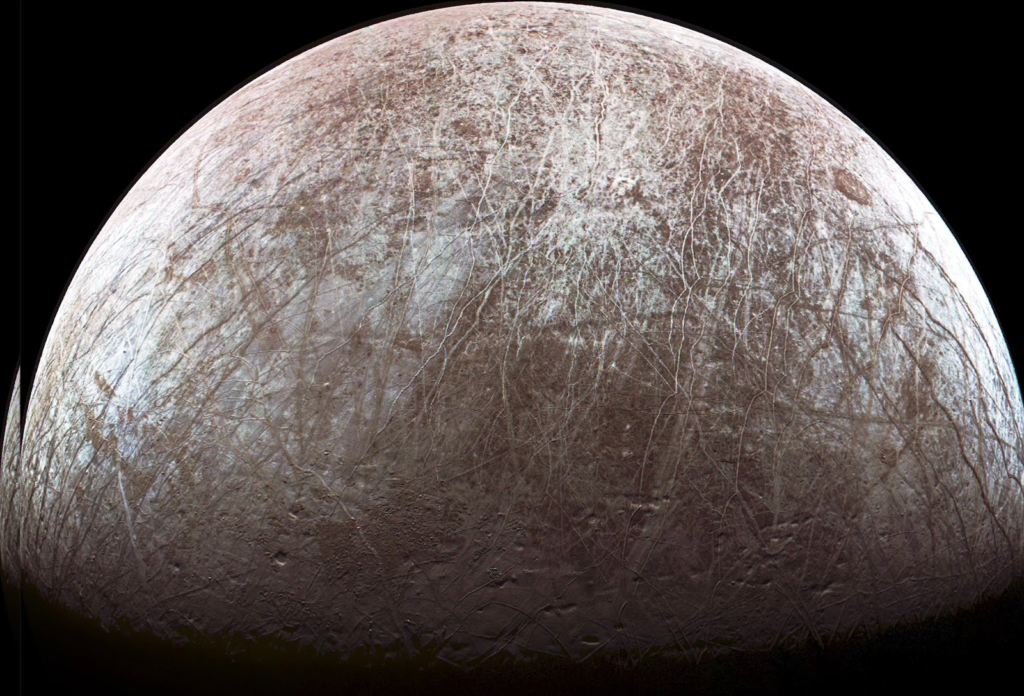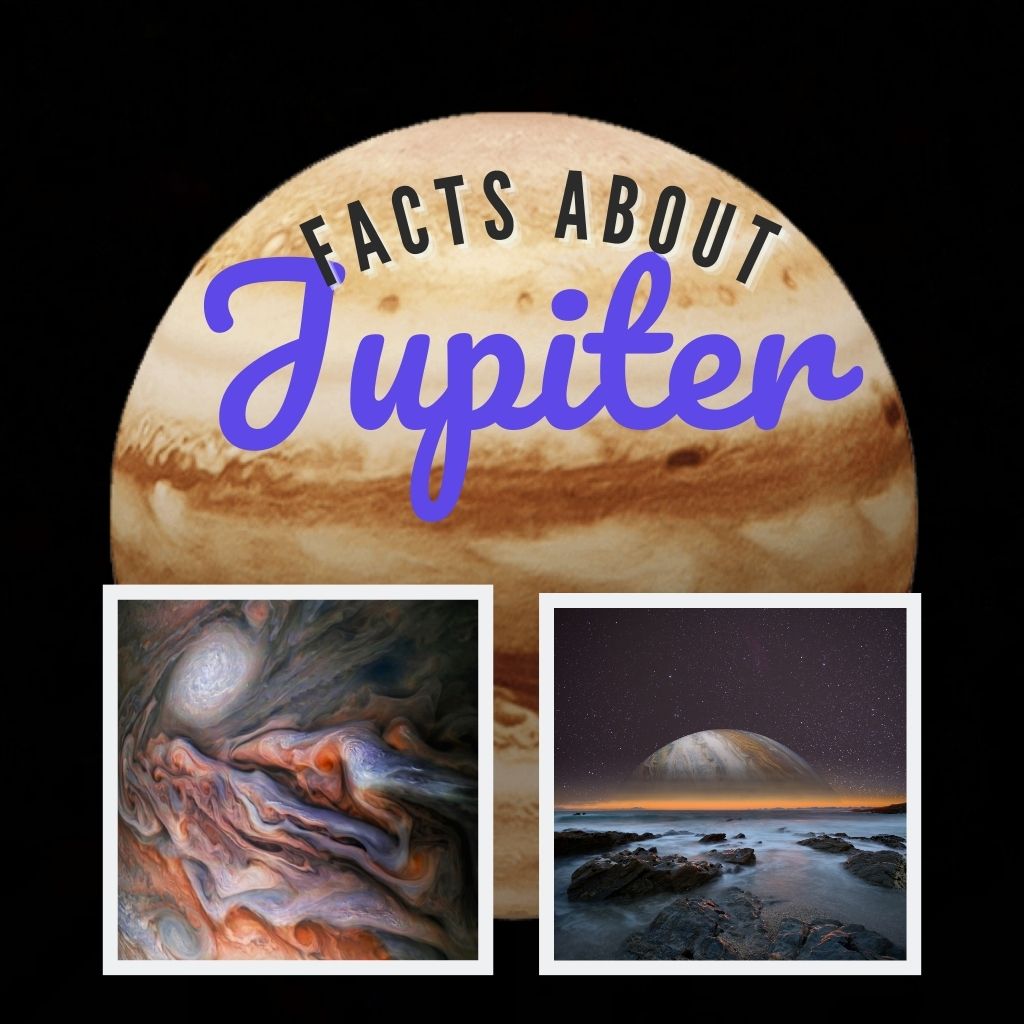This site contains affiliate links to products. I may receive a commission for purchases made through these links.
Jupiter’s distinct, colorful bands and the iconic Great Red Spot have fascinated astronomers for centuries. But there’s much more to this gas giant than its mesmerizing appearance.
This article will explore interesting facts about Jupiter, from its unique magnetic field to its many moons and more. These fascinating tidbits will expand your knowledge and leave you in awe of this incredible planet.
1. Is Jupiter a planet?
Jupiter is a planet. In our solar system, the planet is positioned as the fifth planet. The planet’s atmosphere is highly active, featuring powerful winds that can attain speeds of 600 kilometers per hour.
Jupiter has a strong magnetic field, about 20,000 times stronger than Earth’s. This magnetic field traps particles from the solar wind, creating intense radiation belts around the planet. These radiation belts can pose a danger to spacecraft that pass by Jupiter.
2. Is Jupiter the largest planet?
Jupiter is the largest planet. It is a giant planet as its size is truly enormous. The diameter is over 86,000 miles. Jupiter’s massive size also gives it a powerful gravitational pull.
In fact, the planet Jupiter holds more than double the mass of the collective mass of all other planets in the solar system. Its gravity can affect the orbits of other planets and even deflect asteroids and comets that pass by.
3. Who named the planet Jupiter?
Ancient Roman astronomers named the planet Jupiter. The Roman name for Jupiter was “Iuppiter,” which was eventually shortened to “Jupiter” in English.
4. Is Jupiter a gas planet?
Jupiter is a gas planet, and it primarily comprises hydrogen and helium gas, with small amounts of other elements and compounds.
5. Is Jupiter named after a god?
Jupiter, the planet, derives its name from the Roman god Jove. The Roman deity Jupiter was revered as the god responsible for the skies, thunder, and safeguarding of the Roman empire.
Frequently seen in art, Jove was often portrayed holding symbols of his power, such as an eagle and a thunderbolt.
6. What is Jupiter notable for?
Jupiter is notable for being the largest planet in our solar system and for having a strong magnetic field. Jupiter is also distinguished by the presence of its many moons, with over 79 known satellites orbiting the planet.
The planet’s colorful cloud bands and the Great Red Spot, a giant storm larger than the size of Earth, are also notable features.
7. Why is Jupiter so bright?
Jupiter is so bright because it reflects a significant amount of sunlight. After the Sun, Moon, and Venus, Jupiter is the fourth brightest object. Its brightness is also due to its large size and close proximity to Earth.
If you’re interested in observing Jupiter, there are a variety of telescopes that can help you get a better view of the planet.
One good option is the Celestron NexStar 6SE Telescope. With a 6-inch aperture and user-friendly operation, this telescope is an excellent option for those new to stargazing.
Another telescope you should consider is the Orion SkyQuest XT8 Classic Dobsonian Telescope, which has an 8-inch aperture and provides excellent views of Jupiter and its moons.
Both of these telescopes are designed to be portable, allowing for effortless transportation to the ideal stargazing spots.
While observing Jupiter, it is advisable to use a filter to reduce the planet’s brightness and improve the contrast of its features.
8. Is Jupiter a failed star?
Jupiter is not a failed star. While it is the largest planet in our solar system, it is still much smaller than even the smallest known star.
The formation of stars happens through nuclear fusion, a process that necessitates a much greater mass than what Jupiter possesses.
9. Is Jupiter bigger than the sun?
Jupiter, with a diameter of roughly 86,881 miles (139,822 kilometers), is not as massive as the Sun. The latter has a diameter of about 865,370 miles (1.4 million kilometers).
10. Is Jupiter hot or cold?
Jupiter has an average temperature of -234 degrees Fahrenheit (-145 degrees Celsius), making it a very cold planet.
11. Is Jupiter bigger than Earth?
Jupiter is much larger than Earth. Jupiter has a diameter that is about 11 times larger than Earth’s diameter.
12. Is Jupiter a terrestrial planet?
Jupiter is not a terrestrial planet. It is a Jovian planet. Terrestrial planets are small, rocky, and have a solid surface. Jupiter is a gas giant and does not have a solid surface.
13. Is Jupiter a brown dwarf?
Jupiter is not a brown dwarf. Brown dwarfs are objects that are bigger than giant planets like Jupiter but smaller than stars, and they do not possess enough size to maintain the nuclear fusion processes that fuel stars.
Jupiter, on the other hand, is a gas giant planet and does not have the necessary mass to undergo nuclear fusion and become a star or a brown dwarf.
14. Is Jupiter an outer planet?
Jupiter is considered an outer planet, along with Saturn, Uranus, and Neptune. These planets are located beyond the asteroid belt and are also known as the gas giants.
15. Is Jupiter bigger than Saturn?
Jupiter is bigger than Saturn. Saturn is the second-largest planet in our solar system after Jupiter.
The approximate diameter of Saturn is 72,367 miles (116,460 kilometers), while Jupiter has a diameter of about 86,881 miles (139,822 kilometers).
Jupiter’s ring system is much fainter and less prominent than Saturn’s famous rings.
16. Is Jupiter bigger than some stars?
Jupiter is not bigger than any known star. Even the smallest known stars are much larger than Jupiter.
17. Is Jupiter bigger than Mars?
Jupiter is much larger than Mars. Jupiter has a diameter that is about 22 times larger than Mars’ diameter.
18. Is Jupiter blue?
Jupiter is not blue. The planet’s atmosphere contains many different gases, which interact to create a range of colors, including shades of red, orange, and yellow.
19. Is Jupiter closer to the sun than Earth?
Earth is positioned at a closer distance to the Sun compared to Jupiter. Jupiter holds the position of being the fifth planet from the Sun, while Earth is positioned as the third planet from the Sun.
20. Is Jupiter denser than Earth?
The average density of Jupiter is much lower than that of Earth, recorded at 1.33 grams per cubic centimeter compared to Earth’s average density of 5.5 grams per cubic centimeter.
21. Is Jupiter dark?
Jupiter does not emit light on its own, but it does reflect sunlight and appears as a bright object in the sky.
However, certain features on Jupiter’s surface, such as its famous Great Red Spot, can appear darker than the surrounding areas.
22. Is Jupiter dying?
Jupiter is not dying in the traditional sense, but it is gradually cooling off over time. This means that it is slowly radiating away its internal heat, which causes its atmosphere to contract and its overall diameter to shrink by a few centimeters per year.
23. Is Jupiter expanding or contracting?
Jupiter is gradually cooling off, which causes its atmosphere to contract and its overall diameter to shrink slightly over time. Therefore, Jupiter is contracting rather than expanding.
24. Is Jupiter ever brighter than Venus?
Although Jupiter is one of the brightest objects in the night sky, it is not usually brighter than Venus.
However, there are rare occasions when Jupiter and Venus can appear to be of similar brightness, such as during a planetary conjunction.
25. Is Jupiter flammable?
The major components of Jupiter are hydrogen and helium gases, which are highly flammable under certain conditions. However, there is no oxygen in Jupiter’s atmosphere, so it cannot burn or explode in the way that a planet like Earth could.
26. Is Jupiter getting closer to Earth?
Jupiter’s distance from Earth varies depending on where both planets are in their respective orbits.
However, over long periods, Jupiter’s orbit can change due to gravitational interactions with other planets in the solar system.
As a result, Jupiter’s distance from Earth can vary over millions of years.
27. Is Jupiter’s gravity stronger than Earth’s?
Due to its greater mass, Jupiter’s gravitational pull is considerably stronger than Earth’s. Specifically, Jupiter’s surface gravity is about 2.5 times stronger than Earth’s.
28. Is Jupiter habitable for humans?
The atmosphere of Jupiter primarily consists of gases such as hydrogen and helium, which are not breathable by humans.
Additionally, the extreme temperatures, radiation, and high pressure at Jupiter’s surface would make it impossible for humans to survive there.
29. Is Jupiter in the Milky Way?
Jupiter is located within the Milky Way galaxy, specifically in one of the galaxy’s spiral arms.
30. Is Jupiter in the asteroid belt?
Jupiter is situated outside the asteroid belt, which is a region in the solar system between Mars and Jupiter that contains numerous small, rocky celestial bodies. Jupiter can be found in the outer regions of the solar system.
31. How many moons does Jupiter have?
Jupiter has between 80 and 95 moons, the largest number of any planet in the solar system. The largest of these are known as the Galilean moons.
The four Galilean moons are as follows
Io: The Volcanic Moon
Being the fourth-largest moon in the solar system and the innermost of the Galilean moons, Io is a fascinating celestial body due to its more than 400 active volcanoes, making it the most volcanically active object in the solar system.
The volcanic activity is caused by the tidal forces from Jupiter, which cause the moon’s interior to heat up and melt.
Io has a very thin atmosphere made mostly of sulfur dioxide, and its surface is covered with colorful materials, including sulfur and sulfur compounds.
Europa: The Icy Ocean Moon

Europa is the second-closest of the Galilean moons and is slightly smaller than Earth’s moon. It is one of the most intriguing objects in the solar system.
Due to the presence of a subterranean ocean composed of liquid water, it is considered a promising contender for extraterrestrial life. Europa’s surface is covered with a layer of ice that is thought to be up to 30 kilometers thick.
Ganymede: The largest moon in the solar system

Being larger than Mercury, Ganymede holds the title of the biggest moon in the solar system. It possesses a unique feature as the sole moon with a magnetic field in our solar system.
Ganymede has a rocky, icy surface that is heavily cratered, and it has a thin atmosphere made mostly of oxygen. Scientists believe that Ganymede has a subsurface ocean of liquid water, much like Europa.
Callisto: The Ancient Moon
The second-largest moon in the solar system is Callisto, which also happens to be the farthest of the Galilean moons from its parent planet.
Having a surface that is extensively pocked with craters that have persisted unchanged for billions of years, it is thought to be among the earliest formations in the solar system. Callisto has a very thin atmosphere and no magnetic field, and its surface is covered with ice and rocky material.
You may also like: 11 Best Telescopes to See Jupiter (Planet, Red Spot, and Moons)
32. What is the Great Red Spot on Jupiter?
For a minimum of 400 years, Jupiter’s Great Red Spot has been an enormous storm that continues to persist. It is a massive swirling vortex that is larger than the size of Earth and is visible even from telescopes on Earth.
33. What are the top interesting facts about Jupiter for kids?
There are many interesting facts about Jupiter that kids might find fascinating!
Here are some of the top ones:
- With a diameter that exceeds Earth’s by over 11 times, Jupiter holds the distinction of being the largest planet in the solar system.
- In the solar system, Jupiter experiences the swiftest day, with a duration of roughly 9 hours and 56 minutes.
- Jupiter’s magnetic field is one of the strongest in the solar system, and it extends far beyond the planet itself, affecting its moons and even some of the other planets.
- Jupiter’s atmosphere is incredibly dynamic, with powerful storms, lightning, and strong winds that can reach speeds of up to 620 kilometers per hour.
Takeaway: Explore Interesting facts about Jupiter, the gas planet!
Jupiter is a fascinating planet that continues to captivate scientists and astronomers. Its size, unique features, and system of moons make it a prime target for exploration and research. Jupiter is the biggest planet in the solar system.
Given the continual progression of technology and space exploration, there remains a great deal to discover about Jupiter and its role within the solar system.
Studying Jupiter and its moons can be a rewarding and enlightening experience. Why not examine the biggest planet in our solar system more closely to uncover its hidden mysteries?
You may also like:






